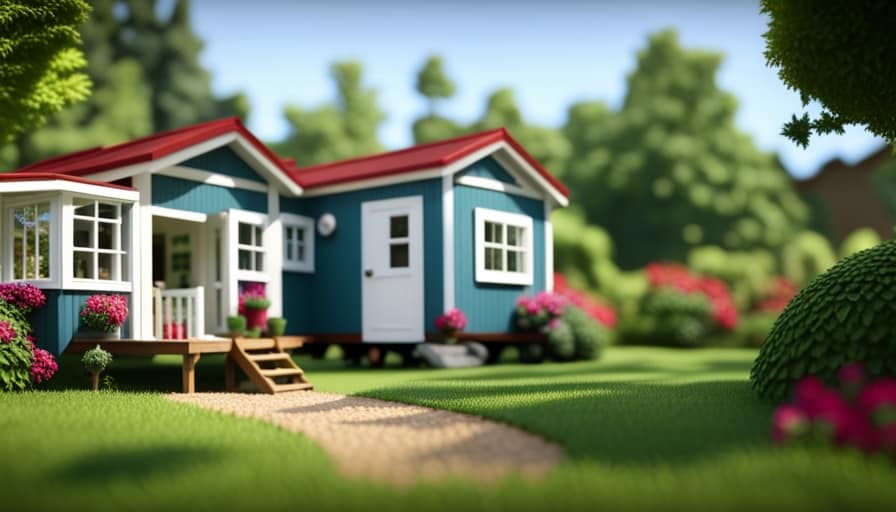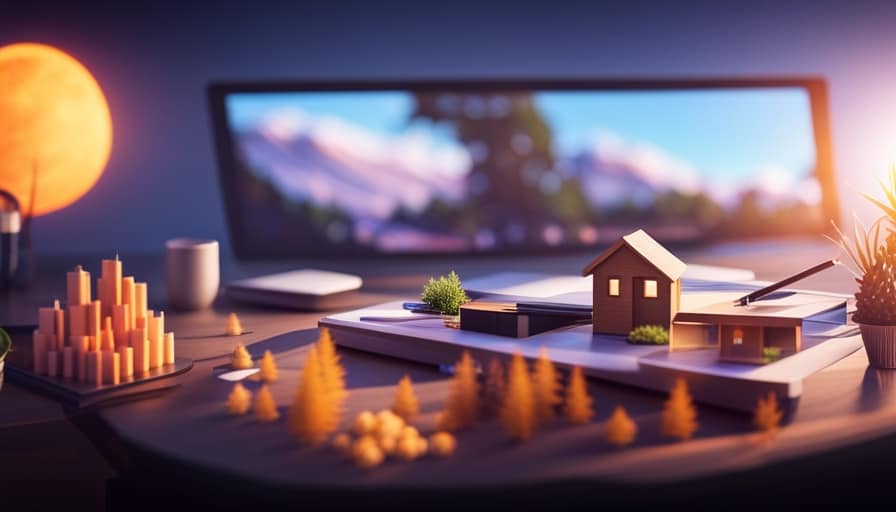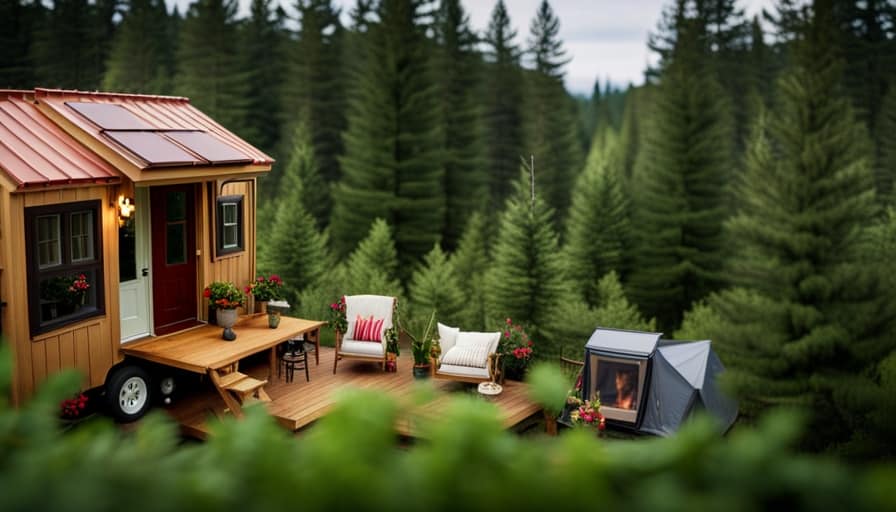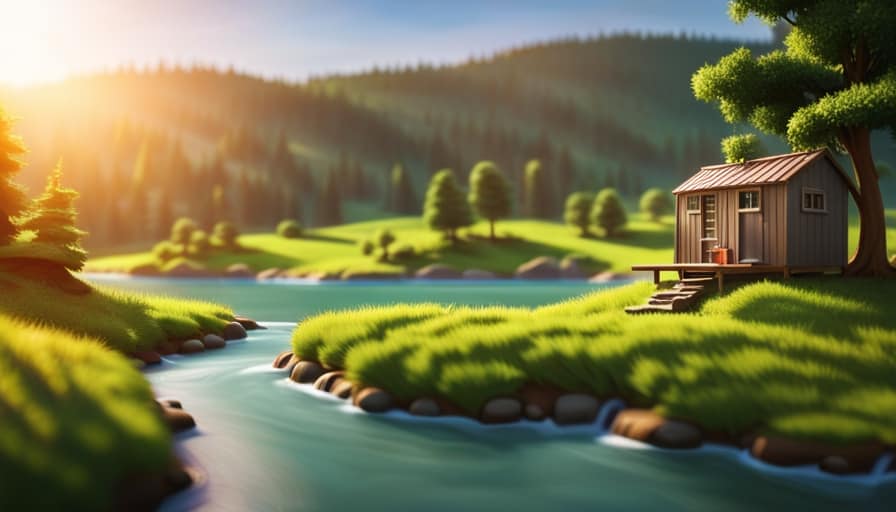As someone who is passionate about tiny houses, I have realized that installing plumbing can be a challenging yet thrilling task. Balancing the small space with the necessary water supply and drainage, it is essential to plan meticulously and execute with precision.
In this article, I will guide you through the steps of designing, connecting, and installing plumbing in a tiny house. Together, we’ll ensure that your tiny home is equipped with a functional and reliable plumbing system, serving your needs with utmost convenience.
Key Takeaways
- Understanding the regulations and requirements specific to tiny house plumbing is essential for safety and functionality.
- Proper planning and design of the plumbing layout is crucial to ensure efficient use of space and water conservation.
- High-quality connectors, pressure regulators, and thorough testing for leaks are important when connecting water supply lines in a tiny house.
- Proper sizing, grading, and the use of appropriate fittings and vents are necessary when installing drainage and sewer lines in a tiny house.
Understanding the Plumbing System in a Tiny House
I’m going to explain the importance of understanding the plumbing system in a tiny house.
When it comes to tiny house plumbing, it’s crucial to be aware of the regulations specific to these compact living spaces. Tiny house plumbing regulations ensure the safety and functionality of the system. Familiarizing yourself with these regulations will help you avoid potential issues and ensure that your plumbing is up to code.

Additionally, understanding the plumbing system will enable you to troubleshoot common plumbing issues that may arise in a tiny house. From leaks and clogs to water pressure problems, being knowledgeable about the plumbing system will empower you to address these issues efficiently and effectively.
Planning and Designing the Plumbing Layout
How can I efficiently plan and design the plumbing layout for my tiny house? When it comes to designing a water-efficient system for your tiny house, it is important to consider both functionality and conservation. One way to achieve this is by incorporating greywater usage into your plumbing layout. Greywater is wastewater from sources such as sinks, showers, and laundry machines, which can be reused for non-potable purposes like irrigation or flushing toilets. By diverting and treating greywater, you can reduce your water consumption and minimize your environmental impact. To help you visualize your plumbing layout, here is a table outlining the key components and their respective locations:
| Component | Location |
|---|---|
| Water heater | Closet or kitchen |
| Water supply | Underneath sink |
| Drainage pipes | Bathroom floor |
| Greywater tank | Outdoor storage |
Connecting Water Supply Lines in a Tiny House
When connecting water supply lines in a tiny house, it’s important to ensure proper fittings are used to prevent leaks and ensure a reliable water flow. Here are four key considerations for connecting water supply lines in a tiny house:
-
Use high-quality connectors: Opt for brass or stainless steel connectors to ensure durability and prevent corrosion. These fittings provide a tight and secure connection.

-
Install pressure regulators: Due to limited space in a tiny house, it’s crucial to regulate the water pressure. Use pressure regulators to maintain a steady flow and prevent damage to plumbing fixtures.
-
Consider flexible hoses: Utilize flexible hoses to connect appliances and fixtures. These hoses allow for easy installation and accommodate any movement or vibrations.
-
Test for leaks: After connecting the water supply lines, thoroughly inspect the system for any leaks. This ensures that the connections are secure and the water flow is uninterrupted.
Now that we’ve discussed connecting water supply lines in a tiny house, let’s move on to the next section about installing drainage and sewer lines.

Installing Drainage and Sewer Lines in a Tiny House
Before starting the installation process, gather all necessary materials and familiarize yourself with the local building codes and regulations to ensure compliance.
When it comes to installing drainage and sewer lines in a tiny house, precision and attention to detail are crucial. Begin by designing the layout of your drainage system, taking into consideration the size and placement of fixtures such as sinks, showers, and toilets. Ensure that all pipes are properly sized and graded to allow for efficient flow and prevent clogs.
When connecting sewer lines, use appropriate fittings and connectors to ensure a secure and watertight connection. It’s also important to install vents to allow for proper air circulation and prevent pressure buildup within the system.
Follow these steps carefully to ensure a well-functioning and efficient drainage system in your tiny house.

Choosing and Installing Fixtures for a Tiny House Plumbing System
I’ll start by researching and selecting the fixtures that best suit my needs and preferences for the tiny house plumbing system. When choosing appropriate fixtures for my tiny house, I’ll prioritize water efficiency to minimize water usage and create a sustainable living environment. Here are four key fixtures that I’ll consider installing:
-
Low-flow showerhead: This fixture reduces water consumption by maintaining a steady flow while using less water, allowing me to enjoy a refreshing shower while conserving resources.
-
Dual-flush toilet: A dual-flush toilet offers two flushing options – a half flush for liquid waste and a full flush for solid waste. This feature helps to significantly decrease water usage without compromising functionality.
-
Water-saving faucets: Installing aerators or flow restrictors on faucets can reduce water flow without sacrificing water pressure. These fixtures ensure I can perform daily tasks efficiently while conserving water.

-
Energy-efficient dishwasher: Opting for an energy-efficient dishwasher not only saves electricity but also reduces water consumption by using less water per cycle.
Frequently Asked Questions
What Are the Different Types of Plumbing Systems Commonly Used in Tiny Houses?
There are different types of plumbing systems commonly used in tiny houses. Each has its pros and cons. It’s important to consider factors like space limitations and water usage needs when choosing the right system for your tiny house.
How Can I Ensure That the Plumbing in My Tiny House Meets Building Codes and Regulations?
To ensure building code compliance, I carefully follow the plumbing installation process. This involves understanding regulations, obtaining necessary permits, and using the correct materials and techniques. Attention to detail is crucial for a successful plumbing system in a tiny house.
What Are Some Tips for Preventing Plumbing Issues in a Tiny House, Such as Frozen Pipes or Leaks?
To prevent plumbing issues in a tiny house, I recommend regular maintenance and taking precautions against frozen pipes and leaks. Insulate pipes, check for leaks regularly, and be mindful of water usage.

Are There Any Specific Considerations or Challenges to Be Aware of When Installing Plumbing in a Mobile Tiny House?
When installing plumbing in a mobile tiny house, there are specific challenges and considerations to be aware of. I can offer installation tips that will help ensure a smooth and efficient process.
Can I Use Alternative or Eco-Friendly Plumbing Materials in My Tiny House, and What Are the Benefits of Doing So?
Using alternative plumbing materials in my tiny house, such as low-flow fixtures and composting toilets, can have many benefits. It reduces water usage, minimizes environmental impact, and promotes a healthier, more sustainable way of living.
Conclusion
In conclusion, installing plumbing in a tiny house is a piece of cake! Just kidding, it’s actually quite a complex process that requires careful planning and design.
From connecting water supply lines to installing drainage and sewer lines, every step needs to be done with precision. And let’s not forget about choosing and installing the fixtures.

So, if you thought plumbing in a regular-sized house was challenging, think again! But with the right knowledge and attention to detail, you’ll have a fully functional plumbing system in your tiny house in no time.
I’m Theodore, and I love tiny houses. In fact, I’m the author of Tiny House 43, a book about tiny houses that are also tree houses. I think they’re magical places where imaginations can run wild and adventures are just waiting to happen.
While tree houses are often associated with childhood, they can be the perfect adult retreat. They offer a cozy space to relax and unwind, surrounded by nature. And since they’re typically built on stilts or raised platforms, they offer stunning views that traditional homes simply can’t match.
If you’re looking for a unique and romantic getaway, a tree house tiny house might just be the perfect option.










